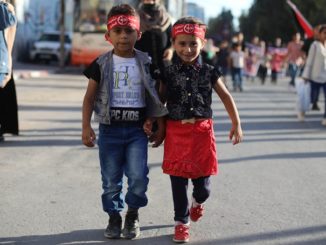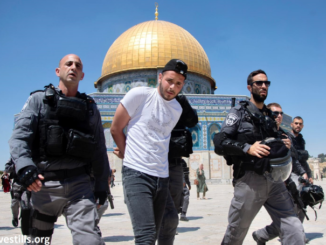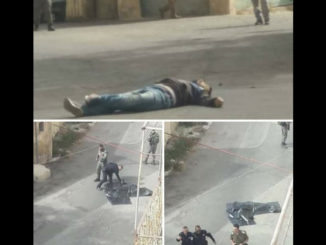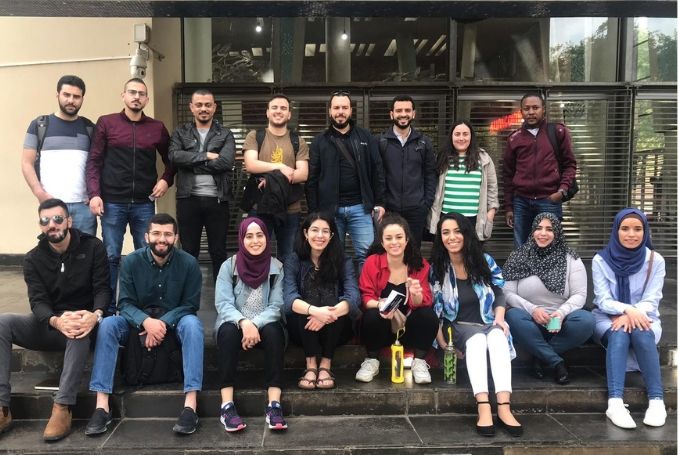
By The Palestinian Youth Movement
From April 1 to April 11, 2019, the Palestinian Youth Movement (PYM), in partnership with the Afro-Middle East Center (AMEC), hosted a delegation of 20 Palestinian youth organizers in Johannesburg, South Africa.
The delegation was driven by three goals: first, to deepen relations of joint-struggle between Palestinians and South Africans; second, to study how we, as Palestinians, can learn from the historic achievements of the South African struggle; and third, to strengthen working relationships among a new generation of Palestinian youths from various geographic and ideological backgrounds toward a unified national liberation project.
The intensive study program featured lectures, seminar discussions, visits to landmark sites of historic struggle, and meetings with South African political figures, community leaders and youth activists.
Our delegation was comprised of Palestinians from the homeland, both from 1948 historic Palestine and the West Bank and Gaza Strip; Palestinian refugees from Lebanon and Syria; and Palestinians living in exile in the United States, in Europe, and the Arab region. In addition to their geographic diversity, the delegates also represented various sociocultural backgrounds, political ideologies, and organizational experiences that exist within Palestinian political and social life globally.
Bringing together Palestinian youth from such different backgrounds has become a critical feature of PYM’s programming over the last decade as we attempt to overcome the fragmentation affecting our role as a new generation in our national struggle. The delegation in South Africa was yet another example of how PYM’s political principles are deeply embedded in our practice.
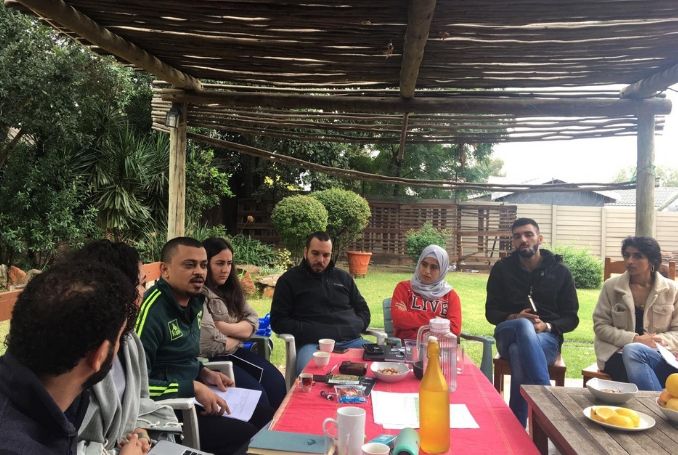
The timeliness of the delegation cannot be overstated. The delegation came at the heels of over a decade of global campaigning for justice in Palestine with the South African struggle’s appeal for boycott, divestment, and sanctions against apartheid as its blueprint. We note that boycott efforts have long been a part of the Palestinian and Third World traditions, even as far back as the 1936 Arab General Strikes. However, the last decade has seen major BDS victories as it has been modeled on the South African case. The delegation also coincided with the South African government’s decision to downgrade its embassy in Tel Aviv.
Just three years ago, Palestinians in Ramallah unveiled a six-meter statue of the late South African leader, Nelson Mandela, gifted by the city of Johannesburg. During the statue honorary ceremony, mayor of Ramallah, Musa Hadid stated that with the statue, Ramallah would send a “clear message to the colonizer and occupier, Israel: we are much closer to freedom than you think.” The emerging parallels and linkages between Palestine and South Africa in many ways informed the purpose of the delegation as an investigative, fact-finding study tour.
The delegation took place nearly a quarter century since both the Oslo Accords and South Africa’s transition out of Apartheid. This period behind us provides us with adequate distance to assess the current Palestinian national condition against the backdrop of a country whose history and ongoing struggles parallel the Palestinian struggle in many ways. We examined why the Palestinian and South African struggles resulted in dramatically different scenarios since the early 1990s.
Further, the delegation allowed for deep and critical reflections on the ethics of solidarity and mechanisms of revitalizing a national frame and internationalist trajectory among Palestinians ourselves. The delegation bore rich discussion amongst its participants and a commitment to building on the experience.
Why South Africa?
PYM chose South Africa for three reasons: first, because of the prominence of the apartheid framework in driving the global Palestine solidarity movement and the use of other frameworks of oppression including settler-colonialism and racial capitalism; second, because of the longstanding histories of joint struggle between the two struggles; and third, because of the parallels and divergent outcomes of the 1990’s negotiations processes in both contexts.
Apartheid Framework: Over the past 10 years, activists and scholars have increasingly assessed the conditions in Palestine through a comparative lens with South Africa, drawing parallels between the Zionist occupation of Palestine and the apartheid system in South Africa. Since its start in 2005, the BDS movement has effectively mobilized the apartheid analogy to further the movement for Palestinian rights and modeled its tactics after those employed by global anti-apartheid struggle: boycotts, corporate disinvestment, and sanctions of Israel.
In addition, the use of international law and human rights law as tools for advocacy for justice in Palestine have grown, as part, and alongside efforts for BDS. The 2002 Rome Statute of the International Criminal Court, which made apartheid an internationally condemned crime, is one example of this.
Dimensions Beyond Apartheid: Beyond examining the apartheid framework, the delegation discussed other dimensions of South Africa’s history and struggle, during both the colonial and Apartheid period and after. We explored the South African struggle through the framework of settler-colonialism — by which land confiscation and the dispossession and elimination of the indigenous people shapes the driving logic of the oppressive order.
We also explored the struggle as one against racial colonialism and racial capitalism, which operates through the extraction of natural resources and the exploitation of native labor.
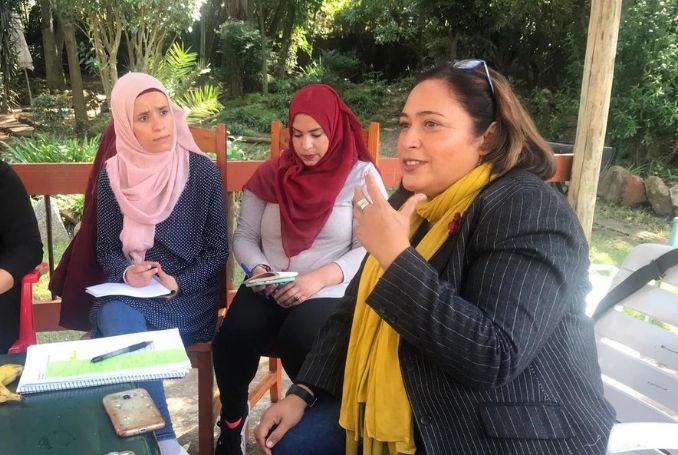
If we, as Palestinians, are to attempt to envision and implement relevant liberation strategies in our own context, we must understand these systems, how they have taken form historically in South Africa, and the remnants of these legacies today. By visiting sites of struggle and meeting with South Africans, we began to see the differences between the Palestinian context and South African context, which are vital to accounting for in devising our liberation strategy. We specifically asked questions about how and why the Zionist colonization does not rely on Palestinian labor and how this presents challenges for us as Palestinians. In the anti-apartheid struggle, South Africans could leverage their labor to make the Apartheid system economically unfeasible.
Joint Struggle: In addition to studying similarities and differences between the two struggles, our delegation sought to better understand the history of Palestinian-South African solidarity, empathy, and joint struggle. Both causes had reciprocal forms of support for one another. During his rise to leadership in the post-Apartheid government, Nelson Mandela made it a point to maintain his commitment and friendship with Yasser Arafat and the Palestinian Liberation Organization (PLO), as he once had recognized Arafat as a comrade in arms and articulated that the Palestinian struggle was similar to the South Africa struggle for they both sought to achieve self-determination. These histories of joint struggle warranted further attention that our delegates engaged immensely in conversations with South African strugglers. Realizing how deep senses of loyalty and shared principles bound the two struggles with another, we also realized how robust the relationship was between Israel and the South African Apartheid government.
1990’s Negotiations Processes: Most critical, we wanted to explore the success and limitations of South Africa’s negotiations process and the establishment and effectiveness of the Truth and Reconciliation Commission. We wanted to understand the conditions of possibility that led to the negotiations, the material reality it had resulted in, and to verify if the negotiations, indeed, had brought about true liberation for the people and land in ending the Apartheid regime.
The youth necessarily asked what differences existed between South African and Palestinian conditions on the eve of negotiations and how the two processes resulted quite differently. We learned that the leadership of the African National Congress came to the negotiating table, not because of a decisive victory, but because of a shift in the international configuration of power with the fall of the Soviet Union, coupled with dwindling resources available to the resistance movement.
Both of those reasons are causes for why the PLO also entered the negotiations process at around the same time. As Dr. Salim Valley, of the Palestine Solidarity Committee, summarized, “We did not have a revolution. We had a negotiated settlement.”
However, a few distinctions exist between the two cases including the mounting international pressures on the Apartheid regime in South Africa, which the Palestinians did not enjoy in the same tenacity at the time. Further, it became clear to us that Mandela effectively negotiated a release of all the political prisoners and return of all exiled leaders before they sat at the official negotiations table.
Lessons Learned about South Africa
One of our greatest realizations was the way the apartheid narrative as a single-story, eclipses South Africa’s extensive history of racial colonialism, settler-colonialism, and racial capitalism. The history book start of Apartheid is marked as 1948 when the South African National Party (the Afrikaner ethnic nationalist party) came to power in government. This largely overlooks that the apartheid system was actually a consolidation of laws implemented by British and Dutch colonial powers.
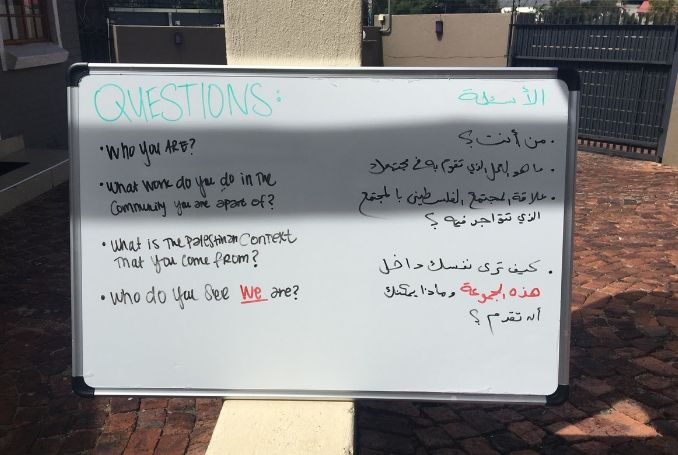
These laws were aimed at subjugating the country’s majority Black population as a cheap labor reserve: dispossessing them of their land, enslaving and exploiting them for production and profit, and sectioning them off to certain racial areas (later referred to as Bantustans) in order to control their movement. This history of colonization dates back to 1652 and 1806 when Dutch and British colonialism created the social, political, and economic conditions of exploitation that shaped what we now refer to as the Apartheid era beginning in 1948.
We also learned about the ways colonialism inflicted gender violence and shaped gender roles and familial relations throughout South Africa’s history. In the interest of controlling and subjugating cheap labor, the Apartheid regime’s policies operated to restrict the movement of Black South African men, systematically keeping them away from their families.
Black South African men faced brutalization and degradation by colonial and apartheid state forces in mines, labor hostels, and prisons, which translated into violent exertion of power over those more vulnerable than them through a system of patriarchy: South African women. Similarly, the state-imposed various methods of sexual and gendered violence upon women’s bodies, which we examined more deeply at the women’s jail at Constitutional Hill.
We heard from women in the anti-apartheid struggle about their experiences navigating patriarchal movement spaces. The persistence of gender violence until today — demonstrated by Johannesburg’s record rates of gender violence — is a direct consequence of a colonial legacy that has gone without redress as part of the national liberation movement. This was a powerful lesson in the indivisibility of social liberation and national liberation for us as Palestinians and makes us take more seriously this relation as we revitalize our own struggle.
After seeing the conditions in Johannesburg and speaking with local community organizations, it became apparent that the 1994 negotiations to end Apartheid in South Africa failed to ensure land and wealth redistribution. They did not account for the inequities that had been in the making through three centuries of colonialism and five decades of de jure apartheid. In effect, power remained largely undistributed which is why, in the “post-Apartheid” period, Whites maintain their historic power in South Africa despite a growing Black political and economic elite and a growing Black middle-class.
Though the South African struggle was comprised of varying ideologies, most prominently reflected in the Pan-African Congress, the African National Congress, and the South African Communist Party, the dominant strands within the movement centered ending Apartheid over ending the racial capitalist order. Where the apartheid framework acknowledges the segregated political, economic, and social conditions of South Africa, it also, by default, naturalizes the presence of White settlers.
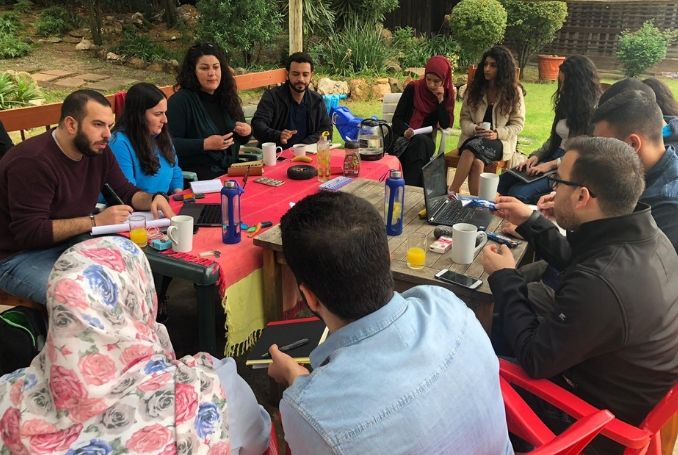
It works to eradicate a system of racial segregation without paying complete attention to racial capitalism and colonial settlement. By addressing primarily the system of discrimination in favor of a “Rainbow Nation,” the process to end apartheid neglected to address the colonial history and capitalist order behind those apartheid laws. The process to end Apartheid was driven by a strong commitment to democratic freedoms, human rights, and an end to state violence.
However, it did not redress the violence of labor and land dispossession and in effect, maintained many of the forms of segregation and inequality from the colonial and apartheid periods, similar to the ongoing struggles for racial justice in a so-called post-Jim Crow United States. We witnessed the ongoing implications of this in the intense security and surveillance systems throughout Johannesburg, in the severe inequities and contrasts in wealth between Sandton and Alexandra Township, and the ongoing movements to reclaim the land.
What Do These Lessons about South Africa Mean for Palestine?
Witnessing South Africa’s persistent social, racial, and economic inequities, that are remnants of colonialism and Apartheid, we problematized the way we, as Palestinians, understand the apartheid analysis. While apartheid is a structural component of the Palestinian colonial condition, it does not comprehensively define it, nor does it prescribe a political solution for us. We recognized the need for our struggle to be informed by a de/anti-colonial praxis in order to obtain full rights and full justice including a redistribution of land, wealth, and power and the actualization of the refugee return to historic Palestine.
It is critical to sustaining global Palestine solidarity efforts for BDS modeled after the South African experience, and the apartheid analogy may be useful for legal advocacy with South Africa, serving as an internationally recognized legal precedent. However, it is important not to allow the apartheid framework to eclipse a fuller understanding of what happened in South Africa nor limit the extent of liberatory possibilities for Palestine. For us, understanding the rise of neoliberal racial capitalist systems developed post-Oslo, and centering these forms of oppression in our liberation strategy are also vital.
Through our study and reflection, we resolved that settler-colonialism, racial colonialism, apartheid, refugeehood, and military occupation are key systems that work together shaping the respective conditions of Palestinian people, and therefore our struggle. These dimensions are what allow for shared principles with other anti-imperialist, de/anti-colonial, and anti-racist causes and movements historically and globally.
However, we articulate the particularities of the Palestinian condition as tied to the ways Zionism has manifested itself. What is sorely needed is a return to a more robust definition of Zionism that will allow the movement for Palestine to see all the various facets of the Palestinian struggle without allowing one framework to overdetermine or limit our broader understanding.
Our Assessment of our Conditions
As Palestinian youth coming from different contexts, reflective of the Palestinian condition, the delegates realized how rare it was for this many diverse experiences to be represented in one space and to be in conversation with one another. For most, it was their first time in a youth-led space that brought together all these Palestinian experiences. This rarity is informed by our geographical fragmentation, limitations in mobility across colonial borders, and the lack of institutional forums to facilitate these exchanges and gatherings in the aftermath of the Oslo Accords. Oslo marked a rupture in the transnational Palestinian body politic and national infrastructure, including institutional forums to archive and learn our political organizing history.
As the Palestinian national trajectory sought to prepare for a state on only a fraction of historic Palestine, the institutional commitment to preparing the new generation for the revolutionary struggle was weakened. We acknowledge the acute need to find ways to overcome both colonial borders and factional tendencies in our society and to revitalize liberatory knowledge-making and access, communal accountability, social wellness, and political cooperation across our pluralism.
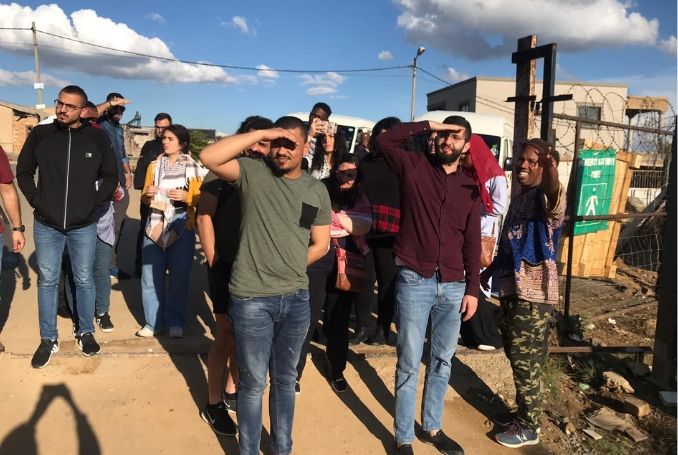
We discussed the way the post-1993 neo-liberalization of Palestine, the development of racial capitalism all while under occupation, has had severe consequences on Palestinian economy and subsequently resulted in a social reordering of Palestinian society. We discussed the normalcy and pervasiveness of the reliance on aid institutions, debt-based economy, and non-governmental organizational industries; all of which play a role in hindering grassroots participation in the Palestinian political project.
We identified the need to develop systems and institutions of self-reliance and sustainability in our organizational efforts as a way to limit the political restrictions of neoliberal debt that was introduced to Palestine exponentially after Oslo and to revitalized popular revolutionary consciousness and community accountability among every day Palestinians struggling against both colonial occupation, displacement and a new Palestinian political and economic elite.
Witnessing the conditions in South Africa and knowing our own history of internationalism, we recognized the need to foster more reciprocal forms of joint struggle with other peoples of the world especially with South Africans themselves who continue to sustain their struggle for an end to government corruption, for a redistribution of land, wealth and power and more. We don’t just want to be recipients of solidarity. We believe we are active agents of history-making. We follow the ethics of camaraderie and want to extend our solidarity with people and places that we have shared interest and shared principles with.
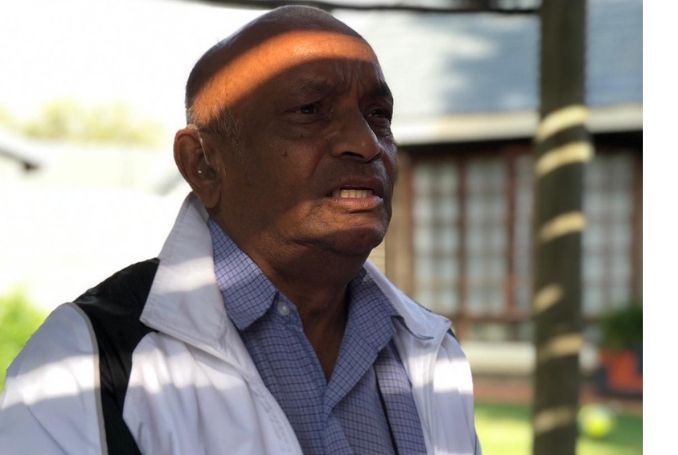
Since the Oslo Accords, we have witnessed the collapse of our national liberation struggle and strategy. Hearing from South African anti-apartheid strugglers, we learned about the role of civil society organizations including unions, popular action committees, and other forums that made up a mass movement of South Africans fighting for justice and liberation. Learning about the roles of the armed struggle, mass popular struggle to make South Africa ungovernable, and the global campaigns to make Apartheid costly, we understand that liberation movements must be multi-faceted, highly organized and insurgent at all levels. Our national liberation movement must also center other forms of social and gender liberation.
Conclusion
We honor the historic strugglers of South Africa and the people today who are still engaging in political work to complete the South African revolution. Their example has provided many invaluable insights into our own struggle. The South African peoples’ consistent display of love, empathy, and solidarity with Palestinians, even and especially when there are violent repercussions for such an extension of support, is something we deeply appreciate.
We left South Africa understanding the need to revitalize and reconstitute a national liberation project that is informed by anti/decolonial frameworks while also rooted in our lived realities. We left wanting to combine a serious diagnosis of our conditions with a revolutionary theoretical explanation of how we got here and how we can get ourselves free. Much work remains to be done, but the conversations and the interactions of the delegation have left us with a great deal to look forward to, and we commence these next steps inspired by a sense of revolutionary optimism.
Moving forward, we plan to continue building on our experience in South Africa through working with the delegates on various campaigns and initiatives and strengthening our networks. We intend on sharing our insights and lessons gained from the delegation through popular education materials and community programming.
Now, more than ever, the time is ripe for a revived anti-colonial framing of the Palestinian cause, and we believe that the various lessons learned and connections made throughout the delegation can help bolster such an understanding of our struggle.
– The Palestinian Youth Movement (“PYM”) is a transnational, independent, grassroots movement of young Palestinians in Palestine and in exile worldwide as a result of the ongoing Zionist colonization and occupation of our homeland. Our belonging to Palestine and our aspirations for justice and liberation motivate us to assume an active role as a young generation in our national struggle for the liberation of our homeland and people. Irrespective of our different political, cultural and social backgrounds, we strive to revive a tradition of pluralistic commitment toward our cause to ensure a better future, characterized by freedom and justice on a social and political level, for ourselves and subsequent generations.

